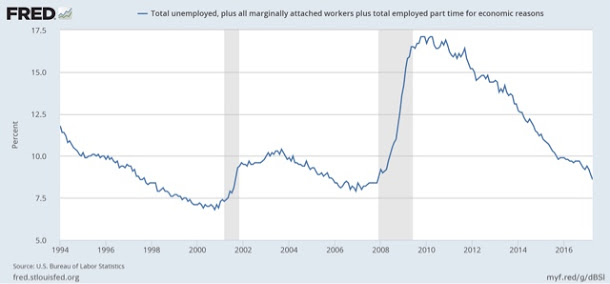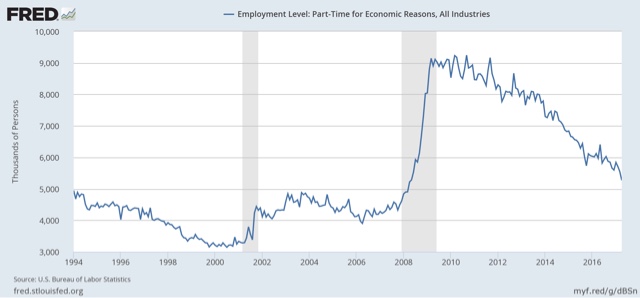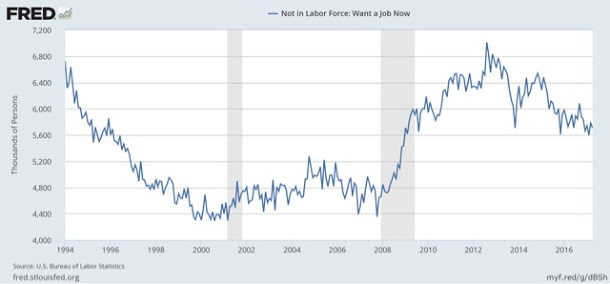By New Deal democrat Scenes from the employment report As I described in my detailed post on the April jobs report, below, almost everything moved in the right direction, and significantly so. Let me lay out a few graphs to show the longer-term stronger and weaker points. In the good news department, the U6 underemployment rate has been falling at a good clip in the last few months, and at 8.6%, is about 0.6% from representing a reasonably “full” employment situation: Part of the U6 calculation is those employed part time for economic reasons. This isn’t down to normal yet, but continues to make good progress: What is particularly good news is that both the U3 and U6 un- and under-employment rates are falling, even though people in the prime working age demographic are coming off the sidelines in substantial numbers: The only other times in the last 30 years there has been a 1%+ increase in prime age labor force participation (red line above) were 1988 and 1995. This *relatively* stout increase in participation is probably an important reason why nominal YoY wage gains for nonsupervisory workers have stalled: Finally, we still have about 1 million or more people who aren’t even bothering to look for work, but would like a job now: This equates to roughly 0.7% of the prime age population. In sum, we still need to move this +0.
Topics:
Dan Crawford considers the following as important: US/Global Economics
This could be interesting, too:
Joel Eissenberg writes How Tesla makes money
Angry Bear writes True pricing: effects on competition
Angry Bear writes The paradox of economic competition
Angry Bear writes USMAC Exempts Certain Items Coming out of Mexico and Canada
by New Deal democrat
Scenes from the employment report
As I described in my detailed post on the April jobs report, below, almost everything moved in the right direction, and significantly so. Let me lay out a few graphs to show the longer-term stronger and weaker points.
In the good news department, the U6 underemployment rate has been falling at a good clip in the last few months, and at 8.6%, is about 0.6% from representing a reasonably “full” employment situation:

Part of the U6 calculation is those employed part time for economic reasons. This isn’t down to normal yet, but continues to make good progress:
What is particularly good news is that both the U3 and U6 un- and under-employment rates are falling, even though people in the prime working age demographic are coming off the sidelines in substantial numbers:
The only other times in the last 30 years there has been a 1%+ increase in prime age labor force participation (red line above) were 1988 and 1995.
This *relatively* stout increase in participation is probably an important reason why nominal YoY wage gains for nonsupervisory workers have stalled:
Finally, we still have about 1 million or more people who aren’t even bothering to look for work, but would like a job now:
This equates to roughly 0.7% of the prime age population.
In sum, we still need to move this +0.7% off the sidelines and into actual employment, and also add another +0.6% or so from underemployment to complete employment before we can say that the the economy is operating at “full employment.” And we are almost 8 years out from the beginning of this expansion, and probably a lot closer to the beginning of the next downturn. This is simply not an economy that in secular terms is working for the average American.




